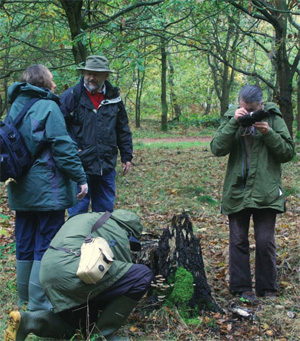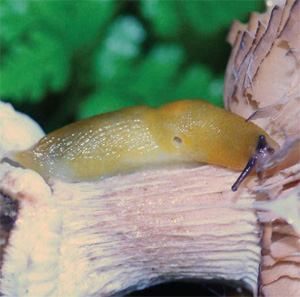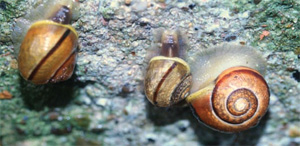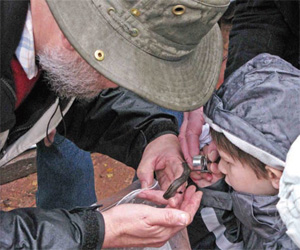|
This is the fourth field visit to the north of Nottinghamshire that I have been privileged to lead. It is always motivating to find new 10km square records and this part of the country is an excellent place for doing that because it is generally under-recorded. However, the lack of species records also results from the thin, free-draining, sandy soils. After the obligatory health-and-safety briefing at the start of the day I gave the bad news and the good news. The bad news - molluscs are likely to be hard to find. The good news - any species which we identify will add to the Sherwood Forest species list which was singularly lacking in mollusc records. The main target species was Malacolimax tenellus. This has one record in the 1979 Atlas to the north of this square. I had rediscovered the species, again in the same square to the north, a year earlier and also a little to the south in another country park - a fragment of Sherwood Forest that is now a conifer plantation. A few days earlier, the species had been found again in the square to the north. Happily, the weather was damp after a long, dry, slug-unfriendly autumn and many fungi were now visible. If the slug was present here, we had a good chance of finding it. We began by walking from the visitor centre, past the “No Entry to the Public” sign (that made us feel important) and I stopped the group at the first heap of fallen wood I saw. Ron advised that we would be better looking under oak than birch wood, but a member of the team, on his first field visit, ignored that advice. The log was rolled over and there lay our target species. Magic! And it was not the only one of the day - more followed in several places. I had never seen so many in a single day. What about other species? It was pretty hard work - but the team members were pretty dedicated. Amongst the mandatory finds of Discus rotundatus and Arion distinctus, we found a small, temporarily unidentifiable species and kept specimens for later. We passed the remains of a military ammunition store (WWII era rather than from the times of Robin Hood). All that remained was a pit with four concrete pillars which was neither attractive nor natural looking. I suggested we stop and look - not for historical interest but simply that it represented a different habitat. We did that - just as well. There were more Cepaea snails there on the concrete pillars than we saw in total during the rest of the day. We also identified the mystery snails and added another species record or two. The mystery species was just Cepaea nemoralis. What was different was that the shell was almost translucent so that internal organs could be seen and the shell was pliable rather than brittle. It seems that the habitat is so calcium-impoverished that young Cepaea snails have difficulty in producing sufficiently thick shells and that only the full adults eventually manage to secure enough calcium to make a shell of normal appearance. The abundance of the snails in the ammunition pit was simply a result of the calcium-rich material of the concrete pillars. What is really gratifying is to see experts struggling with common species which have a different appearance from what is normally expected. There is another lesson for mollusc hunters - always take care to search in different micro-habitats when you see them. Arion ater gave us a problem too. We found many specimens of a small, pinkish-yellow slug climbing trees up to about 1.5 metres. At a glance they could have been dismissed as some Limax species. Close inspection revealed them to be Arion ater, all of this unusually colouration. We began the afternoon session with a look around the public car park. Again, this was worth looking at since it is a different habitat and it turned out to be very worthwhile. There were very few individuals of very few species and we were about to give up. I then saw a shiny something in a small rotting branch lying on the ground. Happy days. It was not Arion ater but a half-grown Limax cinereoniger. What a find - it is a new vice county record. There were a good many people around the visitor centre and I took the opportunity to show this rather special creature to several of them. The reaction was pleasingly unexpected. None of them backed away in disgust. Almost all were fascinated by the rarity and interested to learn a little about its ecology. That did reduce the mollusc hunting time but it was time well spent. What did we not find? I was most surprised not to find any Limax maximus or Lehmannia marginata. The area is very well wooded and very large. It has had forest cover since time immemorial. Even here in the dry east Midlands, it should be suitable habitat for the tree slug. We found not a single one – not for want of looking, either. Curiously we did find two specimens of Lehmannia valentiana - one in the car park (not surprising) and one in the woodland (more surprising). Although we were a small group - just six people overall (Ron Boyce , Marion Bryce, Chris du Feu, Rosemary Hill , Peter Topley, Sam Topley), it was quite a pleasing day with 17 species added to the rangers’ country park list and 3 new 10km records and one new county record. A good PR job was done with the slug visual aid and there was a press release from the very happy park authorities to mark the finding of the special slugs. Subsequent to this, at least one branch of the media read it and I was called by BBC Radio Nottingham for a live interview about the find. I should add that I know the chap who does the programme from previous slug appearances I have made. I was able to give about 5 minutes of Conch Soc. radio exposure time. Species list:
|
Figure 3: Thin shelled juvenile and sub-adult Cepaea nemoralis (Photo Peter Topley)
Figure 4: Chris showing the juvenile L. cinereoniger to an interested young visitor (Photo Rosemary Hill) |
Field trip to the Sherwood Forest area, Nottinghamshire, 24th October 2009
Issue
23
Page
7

 Figure 1: Chris and others in Sherwood Forest (Photo Peter Topley)
Figure 1: Chris and others in Sherwood Forest (Photo Peter Topley) Figure 2: Malacolimax tenellus feeding on fungus (Photo Peter Topley)
Figure 2: Malacolimax tenellus feeding on fungus (Photo Peter Topley)

